Patagonia: A Case Study on Sustainable Business Practices Analysis
VerifiedAdded on 2022/08/27
|13
|3560
|18
Case Study
AI Summary
This case study examines Patagonia's business approach, focusing on sustainability and ethical issues within the context of climate change, supply chain management, and human rights. It evaluates Patagonia's acknowledgment of its environmental impact and analyzes its changed business approach, assessing the implications for future business structures and industry behavior. The study identifies operational and strategic dimensions for implementing Patagonia's approach in other businesses, emphasizing the company's commitment to sustainability over profitability. The analysis covers Patagonia's initiatives in responsible consumption, supply chain management, and the company's response to environmental concerns and labor issues. The study also discusses Patagonia's influence on consumer behavior and the potential for other businesses to adopt similar sustainable practices, including operational and strategic dimensions for environmental preservation and consumer engagement.
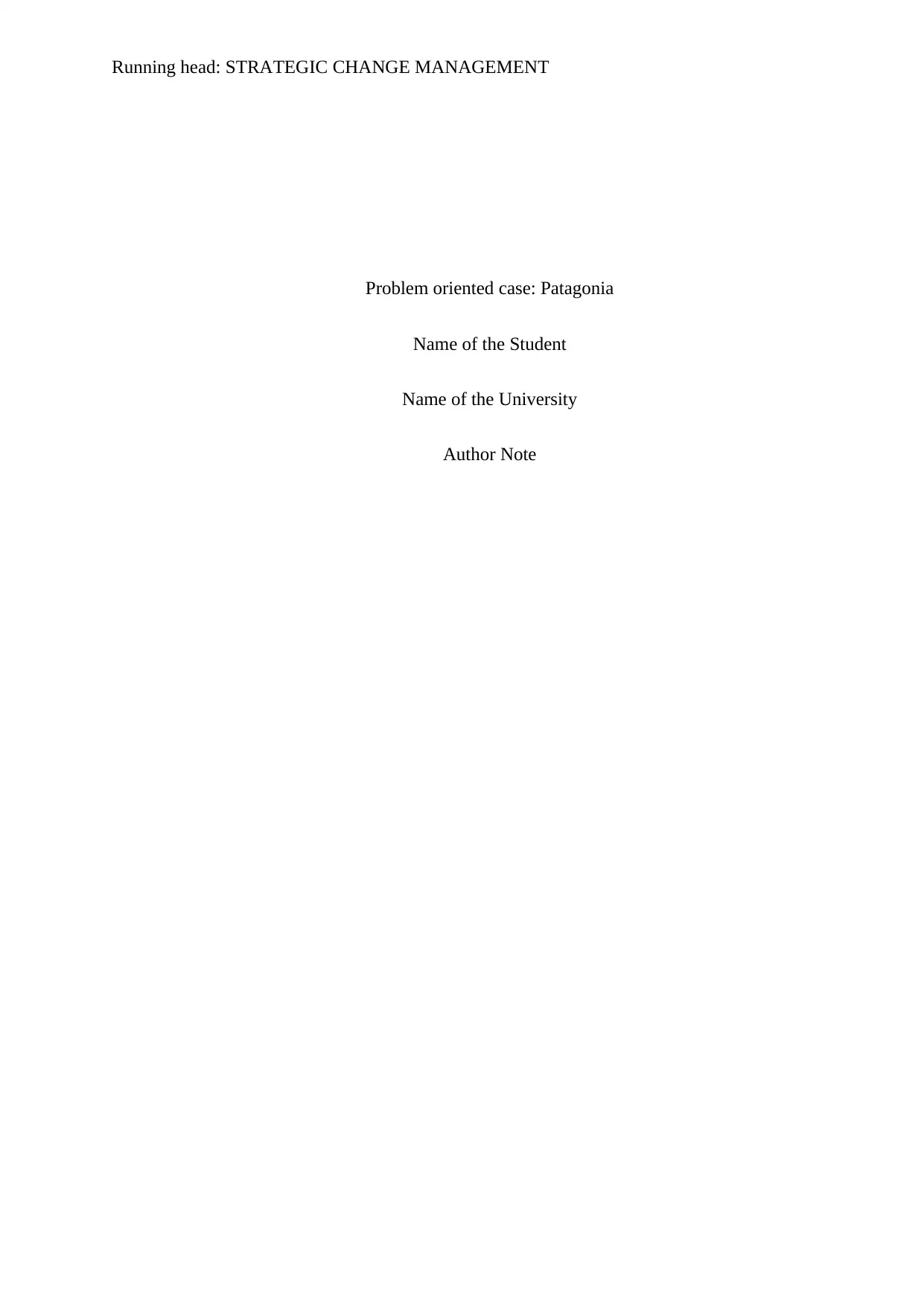
Running head: STRATEGIC CHANGE MANAGEMENT
Problem oriented case: Patagonia
Name of the Student
Name of the University
Author Note
Problem oriented case: Patagonia
Name of the Student
Name of the University
Author Note
Paraphrase This Document
Need a fresh take? Get an instant paraphrase of this document with our AI Paraphraser
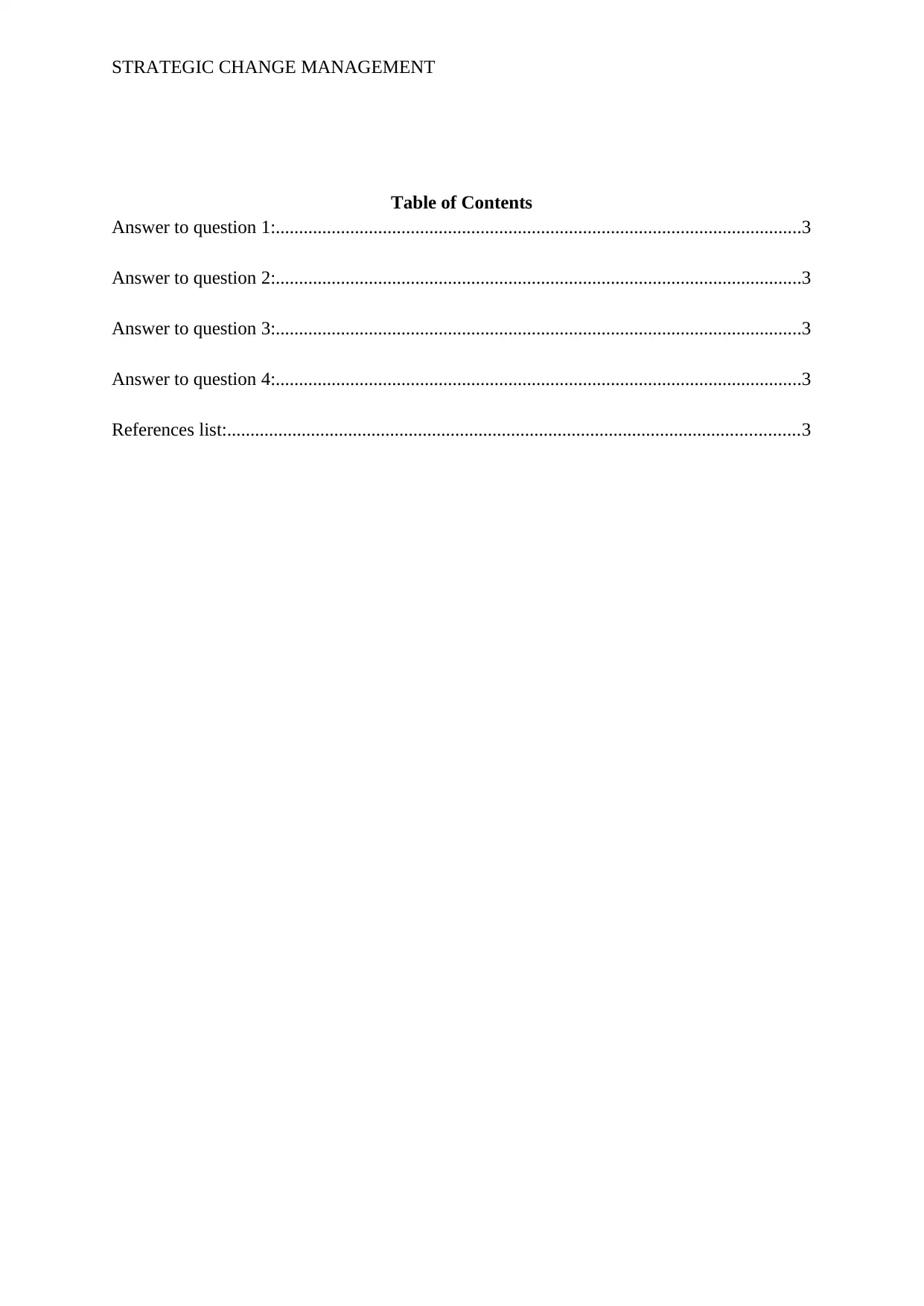
STRATEGIC CHANGE MANAGEMENT
Table of Contents
Answer to question 1:.................................................................................................................3
Answer to question 2:.................................................................................................................3
Answer to question 3:.................................................................................................................3
Answer to question 4:.................................................................................................................3
References list:...........................................................................................................................3
Table of Contents
Answer to question 1:.................................................................................................................3
Answer to question 2:.................................................................................................................3
Answer to question 3:.................................................................................................................3
Answer to question 4:.................................................................................................................3
References list:...........................................................................................................................3
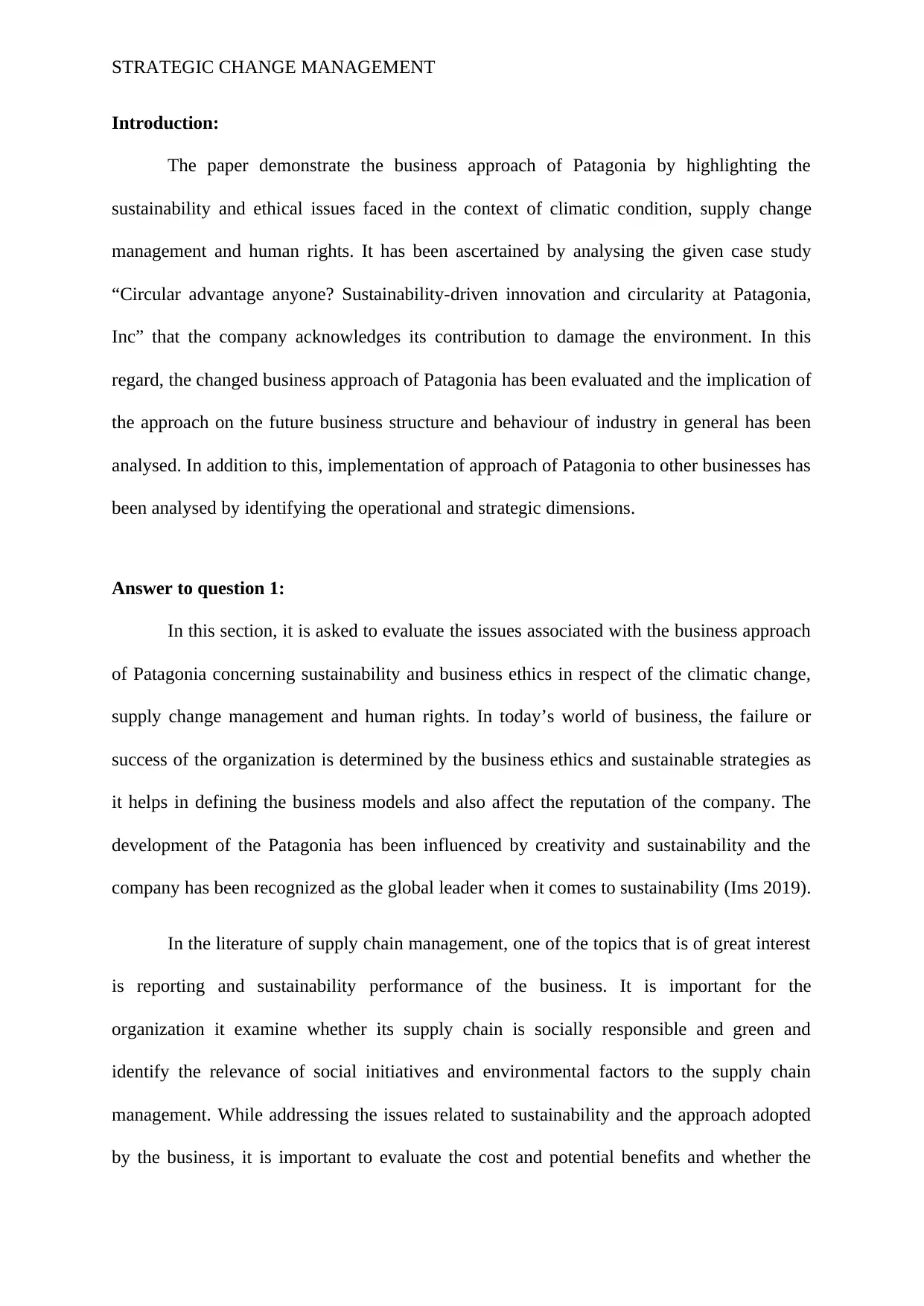
STRATEGIC CHANGE MANAGEMENT
Introduction:
The paper demonstrate the business approach of Patagonia by highlighting the
sustainability and ethical issues faced in the context of climatic condition, supply change
management and human rights. It has been ascertained by analysing the given case study
“Circular advantage anyone? Sustainability-driven innovation and circularity at Patagonia,
Inc” that the company acknowledges its contribution to damage the environment. In this
regard, the changed business approach of Patagonia has been evaluated and the implication of
the approach on the future business structure and behaviour of industry in general has been
analysed. In addition to this, implementation of approach of Patagonia to other businesses has
been analysed by identifying the operational and strategic dimensions.
Answer to question 1:
In this section, it is asked to evaluate the issues associated with the business approach
of Patagonia concerning sustainability and business ethics in respect of the climatic change,
supply change management and human rights. In today’s world of business, the failure or
success of the organization is determined by the business ethics and sustainable strategies as
it helps in defining the business models and also affect the reputation of the company. The
development of the Patagonia has been influenced by creativity and sustainability and the
company has been recognized as the global leader when it comes to sustainability (Ims 2019).
In the literature of supply chain management, one of the topics that is of great interest
is reporting and sustainability performance of the business. It is important for the
organization it examine whether its supply chain is socially responsible and green and
identify the relevance of social initiatives and environmental factors to the supply chain
management. While addressing the issues related to sustainability and the approach adopted
by the business, it is important to evaluate the cost and potential benefits and whether the
Introduction:
The paper demonstrate the business approach of Patagonia by highlighting the
sustainability and ethical issues faced in the context of climatic condition, supply change
management and human rights. It has been ascertained by analysing the given case study
“Circular advantage anyone? Sustainability-driven innovation and circularity at Patagonia,
Inc” that the company acknowledges its contribution to damage the environment. In this
regard, the changed business approach of Patagonia has been evaluated and the implication of
the approach on the future business structure and behaviour of industry in general has been
analysed. In addition to this, implementation of approach of Patagonia to other businesses has
been analysed by identifying the operational and strategic dimensions.
Answer to question 1:
In this section, it is asked to evaluate the issues associated with the business approach
of Patagonia concerning sustainability and business ethics in respect of the climatic change,
supply change management and human rights. In today’s world of business, the failure or
success of the organization is determined by the business ethics and sustainable strategies as
it helps in defining the business models and also affect the reputation of the company. The
development of the Patagonia has been influenced by creativity and sustainability and the
company has been recognized as the global leader when it comes to sustainability (Ims 2019).
In the literature of supply chain management, one of the topics that is of great interest
is reporting and sustainability performance of the business. It is important for the
organization it examine whether its supply chain is socially responsible and green and
identify the relevance of social initiatives and environmental factors to the supply chain
management. While addressing the issues related to sustainability and the approach adopted
by the business, it is important to evaluate the cost and potential benefits and whether the
⊘ This is a preview!⊘
Do you want full access?
Subscribe today to unlock all pages.

Trusted by 1+ million students worldwide
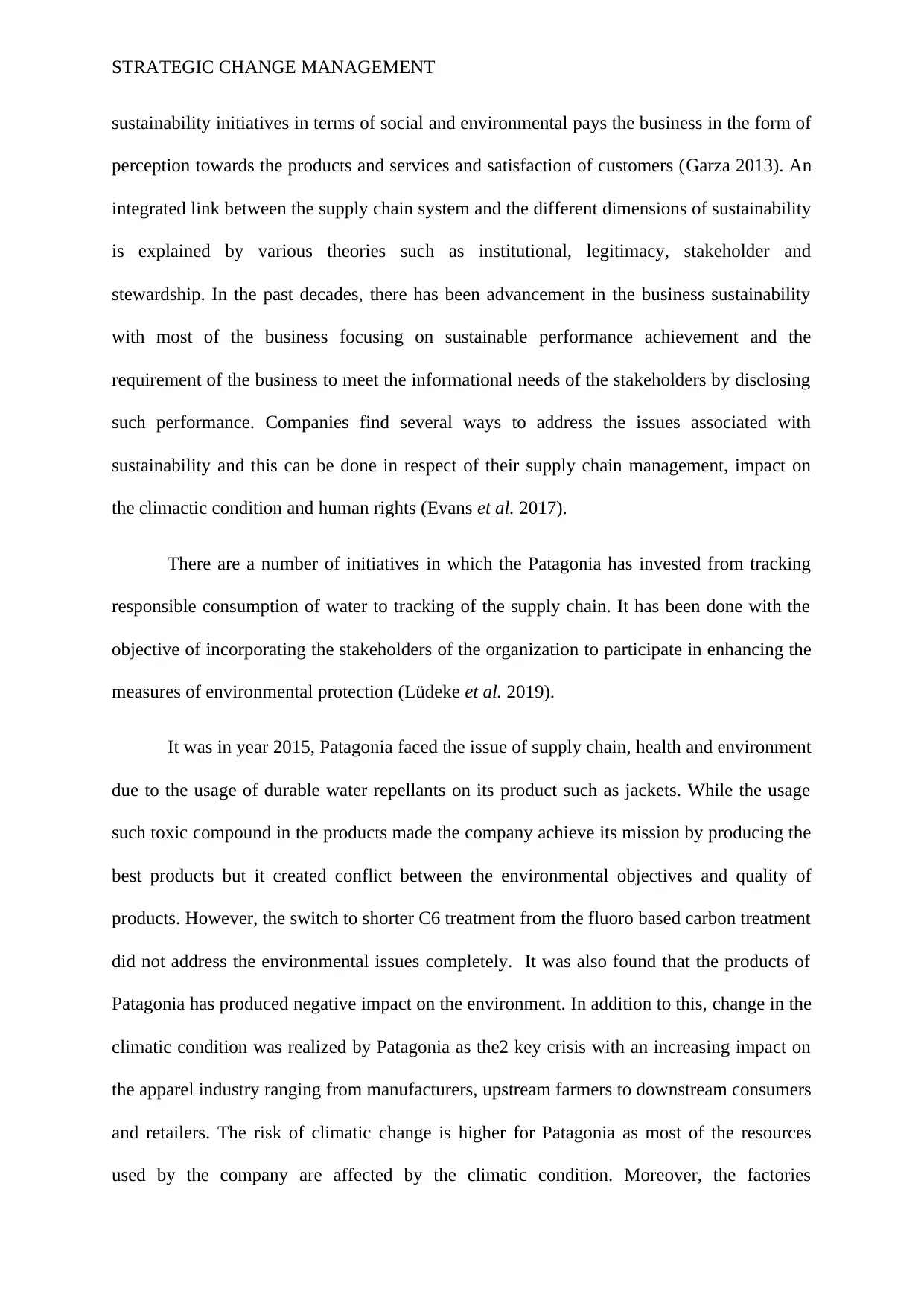
STRATEGIC CHANGE MANAGEMENT
sustainability initiatives in terms of social and environmental pays the business in the form of
perception towards the products and services and satisfaction of customers (Garza 2013). An
integrated link between the supply chain system and the different dimensions of sustainability
is explained by various theories such as institutional, legitimacy, stakeholder and
stewardship. In the past decades, there has been advancement in the business sustainability
with most of the business focusing on sustainable performance achievement and the
requirement of the business to meet the informational needs of the stakeholders by disclosing
such performance. Companies find several ways to address the issues associated with
sustainability and this can be done in respect of their supply chain management, impact on
the climactic condition and human rights (Evans et al. 2017).
There are a number of initiatives in which the Patagonia has invested from tracking
responsible consumption of water to tracking of the supply chain. It has been done with the
objective of incorporating the stakeholders of the organization to participate in enhancing the
measures of environmental protection (Lüdeke et al. 2019).
It was in year 2015, Patagonia faced the issue of supply chain, health and environment
due to the usage of durable water repellants on its product such as jackets. While the usage
such toxic compound in the products made the company achieve its mission by producing the
best products but it created conflict between the environmental objectives and quality of
products. However, the switch to shorter C6 treatment from the fluoro based carbon treatment
did not address the environmental issues completely. It was also found that the products of
Patagonia has produced negative impact on the environment. In addition to this, change in the
climatic condition was realized by Patagonia as the2 key crisis with an increasing impact on
the apparel industry ranging from manufacturers, upstream farmers to downstream consumers
and retailers. The risk of climatic change is higher for Patagonia as most of the resources
used by the company are affected by the climatic condition. Moreover, the factories
sustainability initiatives in terms of social and environmental pays the business in the form of
perception towards the products and services and satisfaction of customers (Garza 2013). An
integrated link between the supply chain system and the different dimensions of sustainability
is explained by various theories such as institutional, legitimacy, stakeholder and
stewardship. In the past decades, there has been advancement in the business sustainability
with most of the business focusing on sustainable performance achievement and the
requirement of the business to meet the informational needs of the stakeholders by disclosing
such performance. Companies find several ways to address the issues associated with
sustainability and this can be done in respect of their supply chain management, impact on
the climactic condition and human rights (Evans et al. 2017).
There are a number of initiatives in which the Patagonia has invested from tracking
responsible consumption of water to tracking of the supply chain. It has been done with the
objective of incorporating the stakeholders of the organization to participate in enhancing the
measures of environmental protection (Lüdeke et al. 2019).
It was in year 2015, Patagonia faced the issue of supply chain, health and environment
due to the usage of durable water repellants on its product such as jackets. While the usage
such toxic compound in the products made the company achieve its mission by producing the
best products but it created conflict between the environmental objectives and quality of
products. However, the switch to shorter C6 treatment from the fluoro based carbon treatment
did not address the environmental issues completely. It was also found that the products of
Patagonia has produced negative impact on the environment. In addition to this, change in the
climatic condition was realized by Patagonia as the2 key crisis with an increasing impact on
the apparel industry ranging from manufacturers, upstream farmers to downstream consumers
and retailers. The risk of climatic change is higher for Patagonia as most of the resources
used by the company are affected by the climatic condition. Moreover, the factories
Paraphrase This Document
Need a fresh take? Get an instant paraphrase of this document with our AI Paraphraser
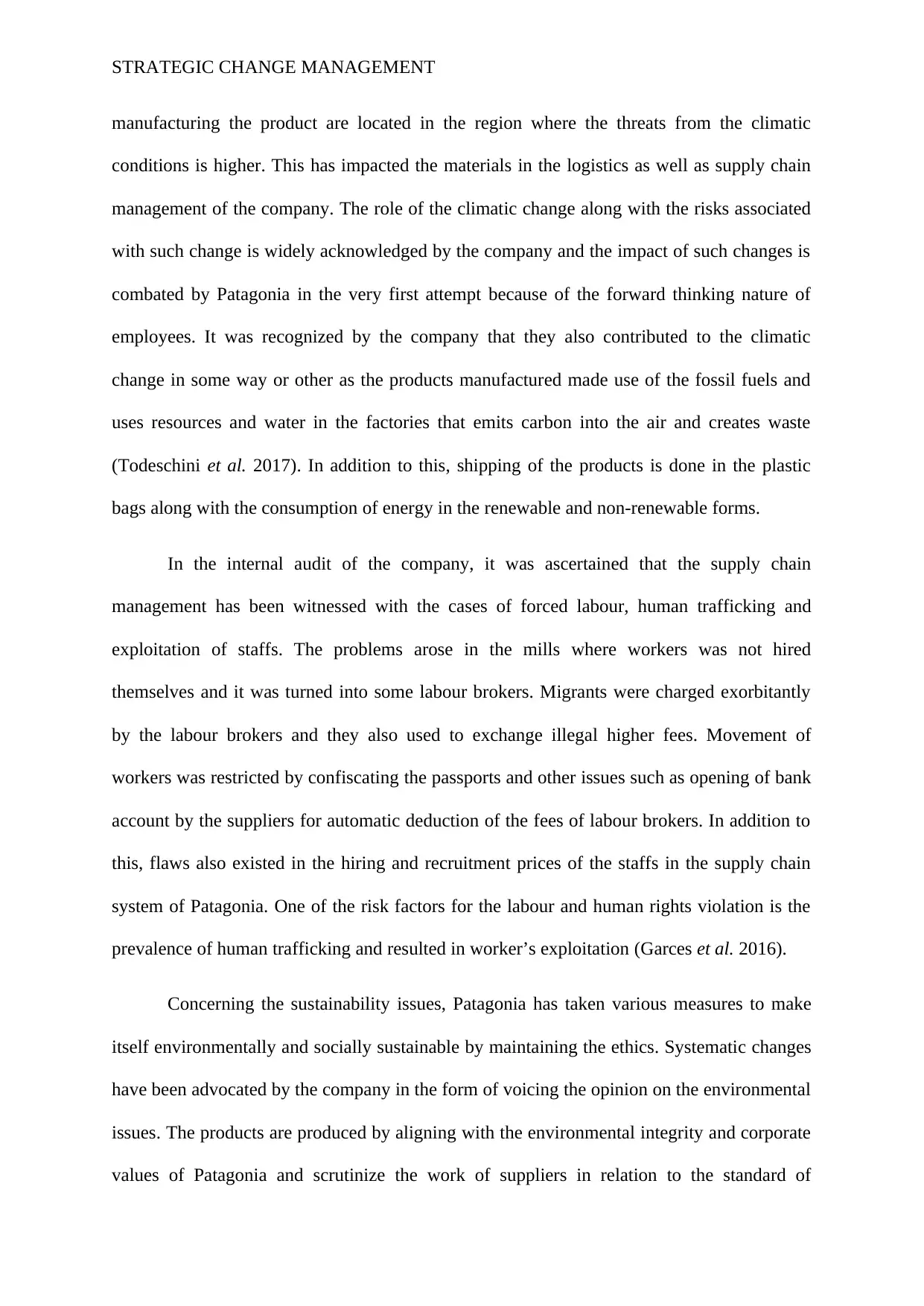
STRATEGIC CHANGE MANAGEMENT
manufacturing the product are located in the region where the threats from the climatic
conditions is higher. This has impacted the materials in the logistics as well as supply chain
management of the company. The role of the climatic change along with the risks associated
with such change is widely acknowledged by the company and the impact of such changes is
combated by Patagonia in the very first attempt because of the forward thinking nature of
employees. It was recognized by the company that they also contributed to the climatic
change in some way or other as the products manufactured made use of the fossil fuels and
uses resources and water in the factories that emits carbon into the air and creates waste
(Todeschini et al. 2017). In addition to this, shipping of the products is done in the plastic
bags along with the consumption of energy in the renewable and non-renewable forms.
In the internal audit of the company, it was ascertained that the supply chain
management has been witnessed with the cases of forced labour, human trafficking and
exploitation of staffs. The problems arose in the mills where workers was not hired
themselves and it was turned into some labour brokers. Migrants were charged exorbitantly
by the labour brokers and they also used to exchange illegal higher fees. Movement of
workers was restricted by confiscating the passports and other issues such as opening of bank
account by the suppliers for automatic deduction of the fees of labour brokers. In addition to
this, flaws also existed in the hiring and recruitment prices of the staffs in the supply chain
system of Patagonia. One of the risk factors for the labour and human rights violation is the
prevalence of human trafficking and resulted in worker’s exploitation (Garces et al. 2016).
Concerning the sustainability issues, Patagonia has taken various measures to make
itself environmentally and socially sustainable by maintaining the ethics. Systematic changes
have been advocated by the company in the form of voicing the opinion on the environmental
issues. The products are produced by aligning with the environmental integrity and corporate
values of Patagonia and scrutinize the work of suppliers in relation to the standard of
manufacturing the product are located in the region where the threats from the climatic
conditions is higher. This has impacted the materials in the logistics as well as supply chain
management of the company. The role of the climatic change along with the risks associated
with such change is widely acknowledged by the company and the impact of such changes is
combated by Patagonia in the very first attempt because of the forward thinking nature of
employees. It was recognized by the company that they also contributed to the climatic
change in some way or other as the products manufactured made use of the fossil fuels and
uses resources and water in the factories that emits carbon into the air and creates waste
(Todeschini et al. 2017). In addition to this, shipping of the products is done in the plastic
bags along with the consumption of energy in the renewable and non-renewable forms.
In the internal audit of the company, it was ascertained that the supply chain
management has been witnessed with the cases of forced labour, human trafficking and
exploitation of staffs. The problems arose in the mills where workers was not hired
themselves and it was turned into some labour brokers. Migrants were charged exorbitantly
by the labour brokers and they also used to exchange illegal higher fees. Movement of
workers was restricted by confiscating the passports and other issues such as opening of bank
account by the suppliers for automatic deduction of the fees of labour brokers. In addition to
this, flaws also existed in the hiring and recruitment prices of the staffs in the supply chain
system of Patagonia. One of the risk factors for the labour and human rights violation is the
prevalence of human trafficking and resulted in worker’s exploitation (Garces et al. 2016).
Concerning the sustainability issues, Patagonia has taken various measures to make
itself environmentally and socially sustainable by maintaining the ethics. Systematic changes
have been advocated by the company in the form of voicing the opinion on the environmental
issues. The products are produced by aligning with the environmental integrity and corporate
values of Patagonia and scrutinize the work of suppliers in relation to the standard of
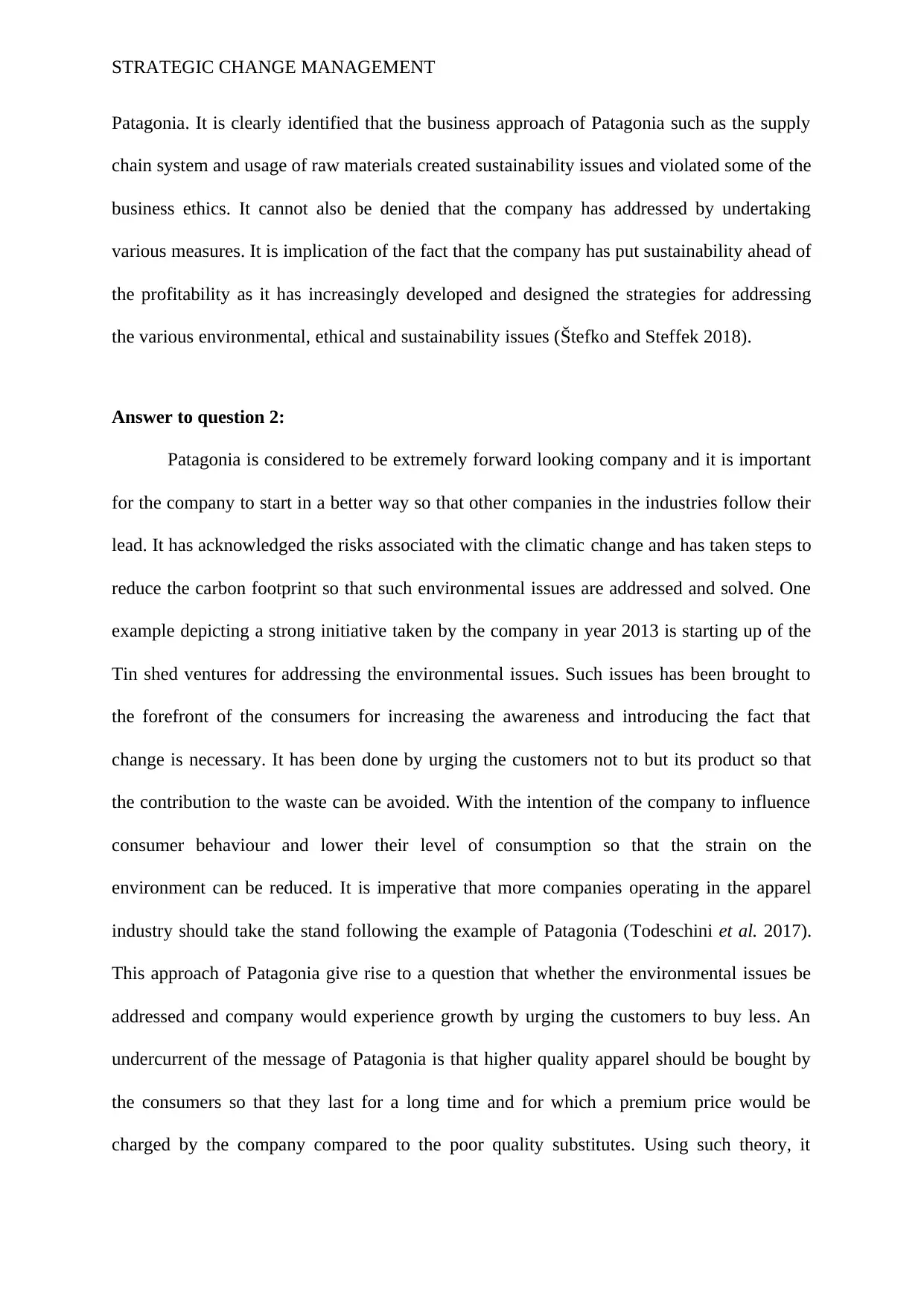
STRATEGIC CHANGE MANAGEMENT
Patagonia. It is clearly identified that the business approach of Patagonia such as the supply
chain system and usage of raw materials created sustainability issues and violated some of the
business ethics. It cannot also be denied that the company has addressed by undertaking
various measures. It is implication of the fact that the company has put sustainability ahead of
the profitability as it has increasingly developed and designed the strategies for addressing
the various environmental, ethical and sustainability issues (Štefko and Steffek 2018).
Answer to question 2:
Patagonia is considered to be extremely forward looking company and it is important
for the company to start in a better way so that other companies in the industries follow their
lead. It has acknowledged the risks associated with the climatic change and has taken steps to
reduce the carbon footprint so that such environmental issues are addressed and solved. One
example depicting a strong initiative taken by the company in year 2013 is starting up of the
Tin shed ventures for addressing the environmental issues. Such issues has been brought to
the forefront of the consumers for increasing the awareness and introducing the fact that
change is necessary. It has been done by urging the customers not to but its product so that
the contribution to the waste can be avoided. With the intention of the company to influence
consumer behaviour and lower their level of consumption so that the strain on the
environment can be reduced. It is imperative that more companies operating in the apparel
industry should take the stand following the example of Patagonia (Todeschini et al. 2017).
This approach of Patagonia give rise to a question that whether the environmental issues be
addressed and company would experience growth by urging the customers to buy less. An
undercurrent of the message of Patagonia is that higher quality apparel should be bought by
the consumers so that they last for a long time and for which a premium price would be
charged by the company compared to the poor quality substitutes. Using such theory, it
Patagonia. It is clearly identified that the business approach of Patagonia such as the supply
chain system and usage of raw materials created sustainability issues and violated some of the
business ethics. It cannot also be denied that the company has addressed by undertaking
various measures. It is implication of the fact that the company has put sustainability ahead of
the profitability as it has increasingly developed and designed the strategies for addressing
the various environmental, ethical and sustainability issues (Štefko and Steffek 2018).
Answer to question 2:
Patagonia is considered to be extremely forward looking company and it is important
for the company to start in a better way so that other companies in the industries follow their
lead. It has acknowledged the risks associated with the climatic change and has taken steps to
reduce the carbon footprint so that such environmental issues are addressed and solved. One
example depicting a strong initiative taken by the company in year 2013 is starting up of the
Tin shed ventures for addressing the environmental issues. Such issues has been brought to
the forefront of the consumers for increasing the awareness and introducing the fact that
change is necessary. It has been done by urging the customers not to but its product so that
the contribution to the waste can be avoided. With the intention of the company to influence
consumer behaviour and lower their level of consumption so that the strain on the
environment can be reduced. It is imperative that more companies operating in the apparel
industry should take the stand following the example of Patagonia (Todeschini et al. 2017).
This approach of Patagonia give rise to a question that whether the environmental issues be
addressed and company would experience growth by urging the customers to buy less. An
undercurrent of the message of Patagonia is that higher quality apparel should be bought by
the consumers so that they last for a long time and for which a premium price would be
charged by the company compared to the poor quality substitutes. Using such theory, it
⊘ This is a preview!⊘
Do you want full access?
Subscribe today to unlock all pages.

Trusted by 1+ million students worldwide
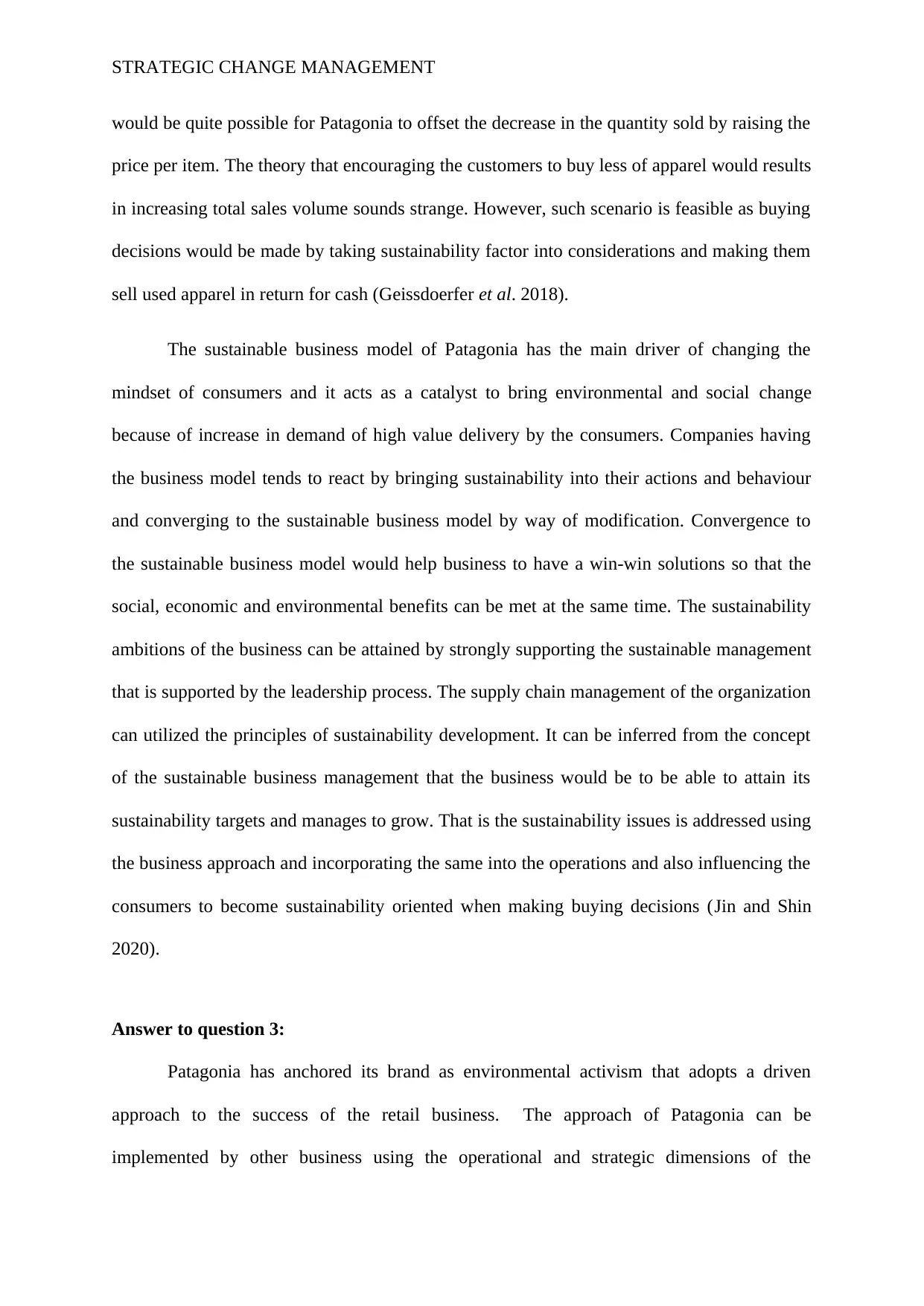
STRATEGIC CHANGE MANAGEMENT
would be quite possible for Patagonia to offset the decrease in the quantity sold by raising the
price per item. The theory that encouraging the customers to buy less of apparel would results
in increasing total sales volume sounds strange. However, such scenario is feasible as buying
decisions would be made by taking sustainability factor into considerations and making them
sell used apparel in return for cash (Geissdoerfer et al. 2018).
The sustainable business model of Patagonia has the main driver of changing the
mindset of consumers and it acts as a catalyst to bring environmental and social change
because of increase in demand of high value delivery by the consumers. Companies having
the business model tends to react by bringing sustainability into their actions and behaviour
and converging to the sustainable business model by way of modification. Convergence to
the sustainable business model would help business to have a win-win solutions so that the
social, economic and environmental benefits can be met at the same time. The sustainability
ambitions of the business can be attained by strongly supporting the sustainable management
that is supported by the leadership process. The supply chain management of the organization
can utilized the principles of sustainability development. It can be inferred from the concept
of the sustainable business management that the business would be to be able to attain its
sustainability targets and manages to grow. That is the sustainability issues is addressed using
the business approach and incorporating the same into the operations and also influencing the
consumers to become sustainability oriented when making buying decisions (Jin and Shin
2020).
Answer to question 3:
Patagonia has anchored its brand as environmental activism that adopts a driven
approach to the success of the retail business. The approach of Patagonia can be
implemented by other business using the operational and strategic dimensions of the
would be quite possible for Patagonia to offset the decrease in the quantity sold by raising the
price per item. The theory that encouraging the customers to buy less of apparel would results
in increasing total sales volume sounds strange. However, such scenario is feasible as buying
decisions would be made by taking sustainability factor into considerations and making them
sell used apparel in return for cash (Geissdoerfer et al. 2018).
The sustainable business model of Patagonia has the main driver of changing the
mindset of consumers and it acts as a catalyst to bring environmental and social change
because of increase in demand of high value delivery by the consumers. Companies having
the business model tends to react by bringing sustainability into their actions and behaviour
and converging to the sustainable business model by way of modification. Convergence to
the sustainable business model would help business to have a win-win solutions so that the
social, economic and environmental benefits can be met at the same time. The sustainability
ambitions of the business can be attained by strongly supporting the sustainable management
that is supported by the leadership process. The supply chain management of the organization
can utilized the principles of sustainability development. It can be inferred from the concept
of the sustainable business management that the business would be to be able to attain its
sustainability targets and manages to grow. That is the sustainability issues is addressed using
the business approach and incorporating the same into the operations and also influencing the
consumers to become sustainability oriented when making buying decisions (Jin and Shin
2020).
Answer to question 3:
Patagonia has anchored its brand as environmental activism that adopts a driven
approach to the success of the retail business. The approach of Patagonia can be
implemented by other business using the operational and strategic dimensions of the
Paraphrase This Document
Need a fresh take? Get an instant paraphrase of this document with our AI Paraphraser
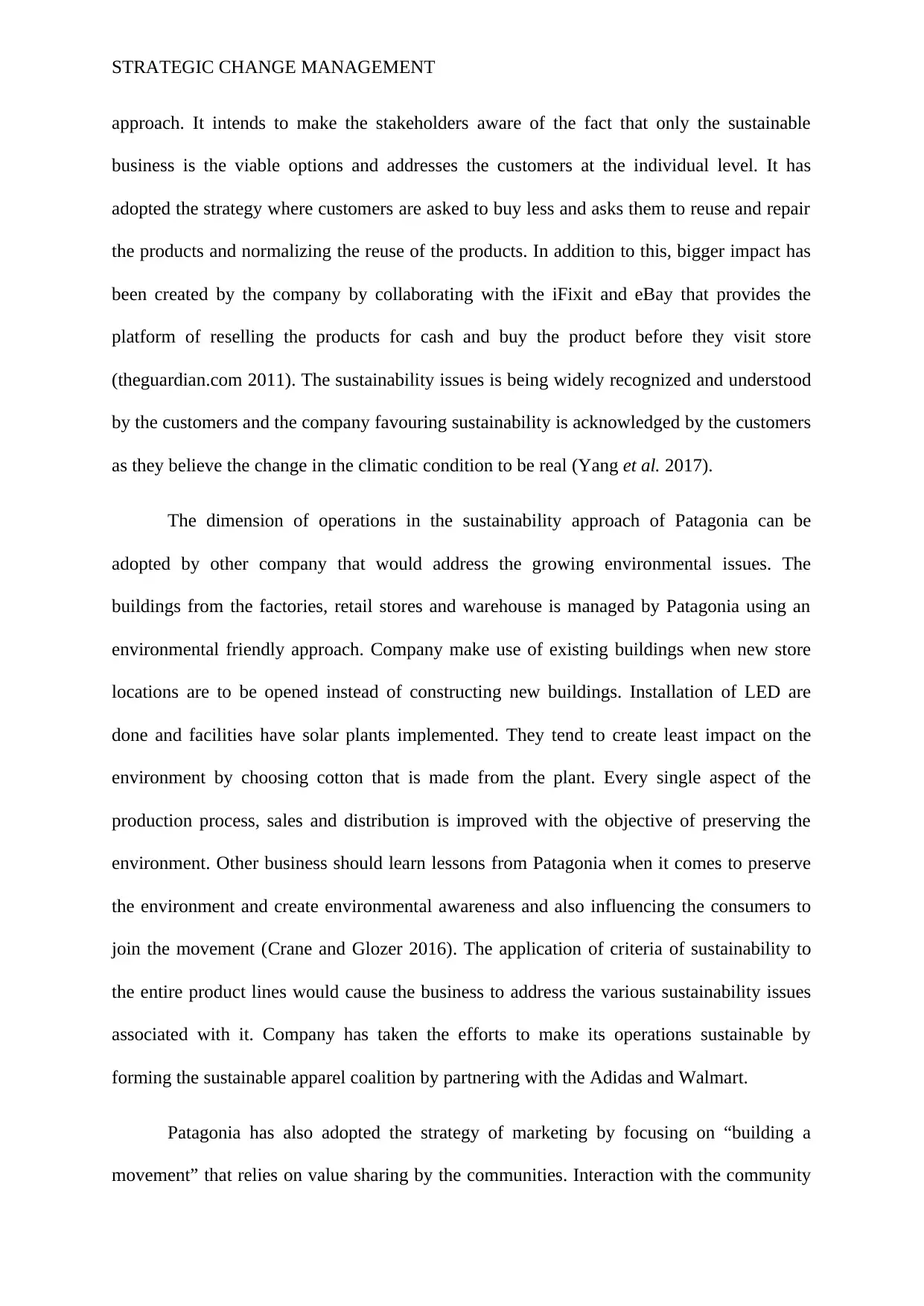
STRATEGIC CHANGE MANAGEMENT
approach. It intends to make the stakeholders aware of the fact that only the sustainable
business is the viable options and addresses the customers at the individual level. It has
adopted the strategy where customers are asked to buy less and asks them to reuse and repair
the products and normalizing the reuse of the products. In addition to this, bigger impact has
been created by the company by collaborating with the iFixit and eBay that provides the
platform of reselling the products for cash and buy the product before they visit store
(theguardian.com 2011). The sustainability issues is being widely recognized and understood
by the customers and the company favouring sustainability is acknowledged by the customers
as they believe the change in the climatic condition to be real (Yang et al. 2017).
The dimension of operations in the sustainability approach of Patagonia can be
adopted by other company that would address the growing environmental issues. The
buildings from the factories, retail stores and warehouse is managed by Patagonia using an
environmental friendly approach. Company make use of existing buildings when new store
locations are to be opened instead of constructing new buildings. Installation of LED are
done and facilities have solar plants implemented. They tend to create least impact on the
environment by choosing cotton that is made from the plant. Every single aspect of the
production process, sales and distribution is improved with the objective of preserving the
environment. Other business should learn lessons from Patagonia when it comes to preserve
the environment and create environmental awareness and also influencing the consumers to
join the movement (Crane and Glozer 2016). The application of criteria of sustainability to
the entire product lines would cause the business to address the various sustainability issues
associated with it. Company has taken the efforts to make its operations sustainable by
forming the sustainable apparel coalition by partnering with the Adidas and Walmart.
Patagonia has also adopted the strategy of marketing by focusing on “building a
movement” that relies on value sharing by the communities. Interaction with the community
approach. It intends to make the stakeholders aware of the fact that only the sustainable
business is the viable options and addresses the customers at the individual level. It has
adopted the strategy where customers are asked to buy less and asks them to reuse and repair
the products and normalizing the reuse of the products. In addition to this, bigger impact has
been created by the company by collaborating with the iFixit and eBay that provides the
platform of reselling the products for cash and buy the product before they visit store
(theguardian.com 2011). The sustainability issues is being widely recognized and understood
by the customers and the company favouring sustainability is acknowledged by the customers
as they believe the change in the climatic condition to be real (Yang et al. 2017).
The dimension of operations in the sustainability approach of Patagonia can be
adopted by other company that would address the growing environmental issues. The
buildings from the factories, retail stores and warehouse is managed by Patagonia using an
environmental friendly approach. Company make use of existing buildings when new store
locations are to be opened instead of constructing new buildings. Installation of LED are
done and facilities have solar plants implemented. They tend to create least impact on the
environment by choosing cotton that is made from the plant. Every single aspect of the
production process, sales and distribution is improved with the objective of preserving the
environment. Other business should learn lessons from Patagonia when it comes to preserve
the environment and create environmental awareness and also influencing the consumers to
join the movement (Crane and Glozer 2016). The application of criteria of sustainability to
the entire product lines would cause the business to address the various sustainability issues
associated with it. Company has taken the efforts to make its operations sustainable by
forming the sustainable apparel coalition by partnering with the Adidas and Walmart.
Patagonia has also adopted the strategy of marketing by focusing on “building a
movement” that relies on value sharing by the communities. Interaction with the community
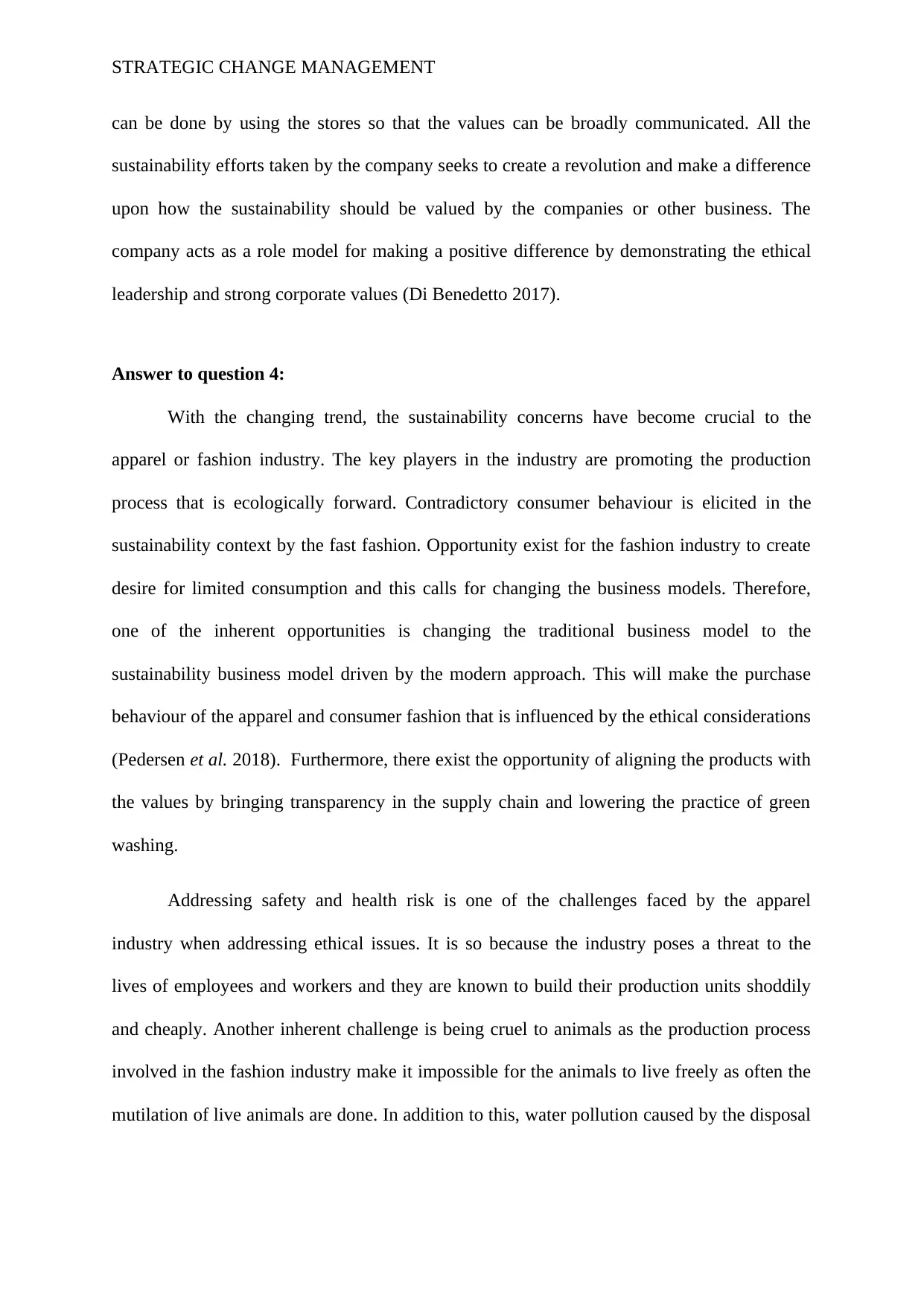
STRATEGIC CHANGE MANAGEMENT
can be done by using the stores so that the values can be broadly communicated. All the
sustainability efforts taken by the company seeks to create a revolution and make a difference
upon how the sustainability should be valued by the companies or other business. The
company acts as a role model for making a positive difference by demonstrating the ethical
leadership and strong corporate values (Di Benedetto 2017).
Answer to question 4:
With the changing trend, the sustainability concerns have become crucial to the
apparel or fashion industry. The key players in the industry are promoting the production
process that is ecologically forward. Contradictory consumer behaviour is elicited in the
sustainability context by the fast fashion. Opportunity exist for the fashion industry to create
desire for limited consumption and this calls for changing the business models. Therefore,
one of the inherent opportunities is changing the traditional business model to the
sustainability business model driven by the modern approach. This will make the purchase
behaviour of the apparel and consumer fashion that is influenced by the ethical considerations
(Pedersen et al. 2018). Furthermore, there exist the opportunity of aligning the products with
the values by bringing transparency in the supply chain and lowering the practice of green
washing.
Addressing safety and health risk is one of the challenges faced by the apparel
industry when addressing ethical issues. It is so because the industry poses a threat to the
lives of employees and workers and they are known to build their production units shoddily
and cheaply. Another inherent challenge is being cruel to animals as the production process
involved in the fashion industry make it impossible for the animals to live freely as often the
mutilation of live animals are done. In addition to this, water pollution caused by the disposal
can be done by using the stores so that the values can be broadly communicated. All the
sustainability efforts taken by the company seeks to create a revolution and make a difference
upon how the sustainability should be valued by the companies or other business. The
company acts as a role model for making a positive difference by demonstrating the ethical
leadership and strong corporate values (Di Benedetto 2017).
Answer to question 4:
With the changing trend, the sustainability concerns have become crucial to the
apparel or fashion industry. The key players in the industry are promoting the production
process that is ecologically forward. Contradictory consumer behaviour is elicited in the
sustainability context by the fast fashion. Opportunity exist for the fashion industry to create
desire for limited consumption and this calls for changing the business models. Therefore,
one of the inherent opportunities is changing the traditional business model to the
sustainability business model driven by the modern approach. This will make the purchase
behaviour of the apparel and consumer fashion that is influenced by the ethical considerations
(Pedersen et al. 2018). Furthermore, there exist the opportunity of aligning the products with
the values by bringing transparency in the supply chain and lowering the practice of green
washing.
Addressing safety and health risk is one of the challenges faced by the apparel
industry when addressing ethical issues. It is so because the industry poses a threat to the
lives of employees and workers and they are known to build their production units shoddily
and cheaply. Another inherent challenge is being cruel to animals as the production process
involved in the fashion industry make it impossible for the animals to live freely as often the
mutilation of live animals are done. In addition to this, water pollution caused by the disposal
⊘ This is a preview!⊘
Do you want full access?
Subscribe today to unlock all pages.

Trusted by 1+ million students worldwide
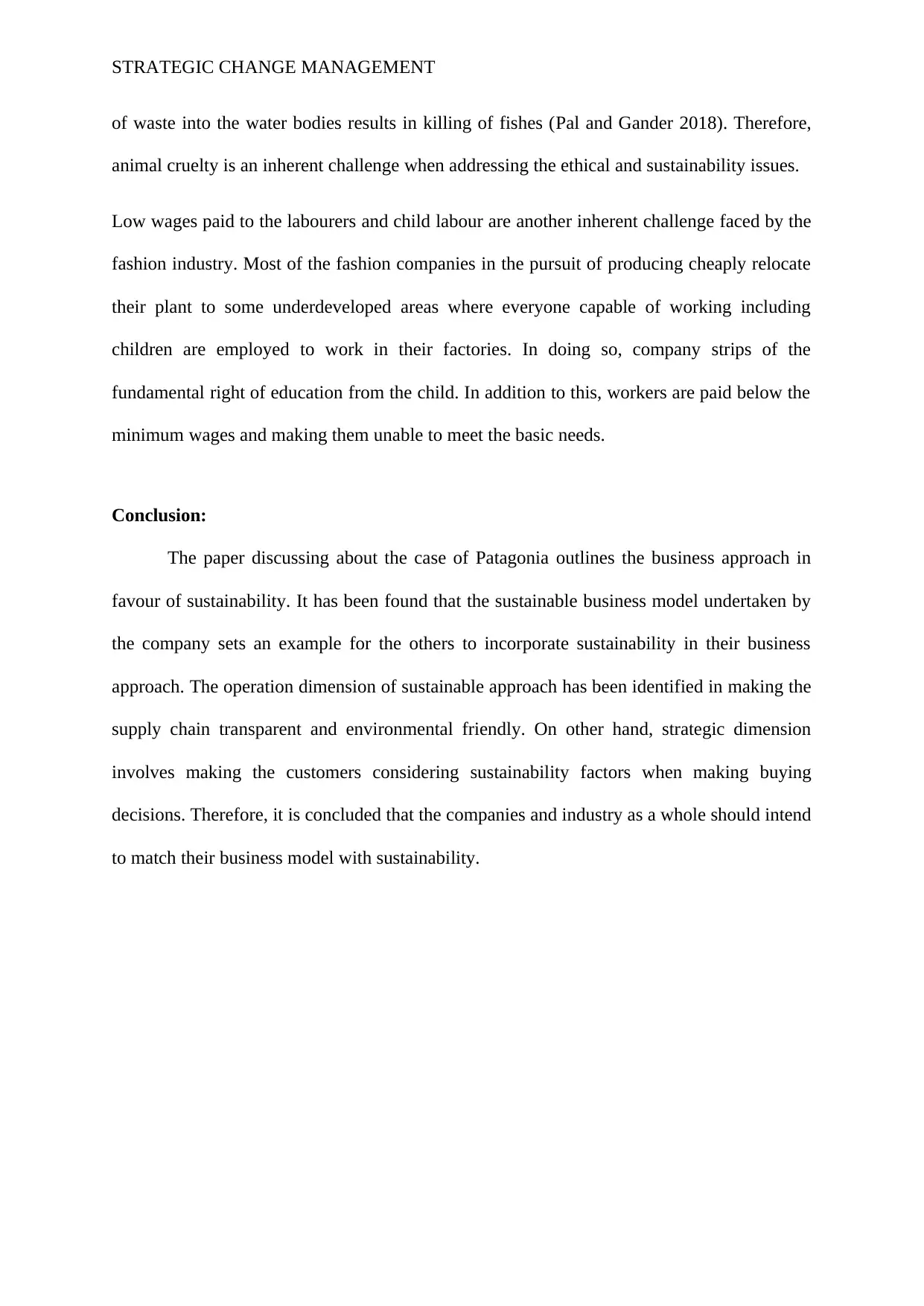
STRATEGIC CHANGE MANAGEMENT
of waste into the water bodies results in killing of fishes (Pal and Gander 2018). Therefore,
animal cruelty is an inherent challenge when addressing the ethical and sustainability issues.
Low wages paid to the labourers and child labour are another inherent challenge faced by the
fashion industry. Most of the fashion companies in the pursuit of producing cheaply relocate
their plant to some underdeveloped areas where everyone capable of working including
children are employed to work in their factories. In doing so, company strips of the
fundamental right of education from the child. In addition to this, workers are paid below the
minimum wages and making them unable to meet the basic needs.
Conclusion:
The paper discussing about the case of Patagonia outlines the business approach in
favour of sustainability. It has been found that the sustainable business model undertaken by
the company sets an example for the others to incorporate sustainability in their business
approach. The operation dimension of sustainable approach has been identified in making the
supply chain transparent and environmental friendly. On other hand, strategic dimension
involves making the customers considering sustainability factors when making buying
decisions. Therefore, it is concluded that the companies and industry as a whole should intend
to match their business model with sustainability.
of waste into the water bodies results in killing of fishes (Pal and Gander 2018). Therefore,
animal cruelty is an inherent challenge when addressing the ethical and sustainability issues.
Low wages paid to the labourers and child labour are another inherent challenge faced by the
fashion industry. Most of the fashion companies in the pursuit of producing cheaply relocate
their plant to some underdeveloped areas where everyone capable of working including
children are employed to work in their factories. In doing so, company strips of the
fundamental right of education from the child. In addition to this, workers are paid below the
minimum wages and making them unable to meet the basic needs.
Conclusion:
The paper discussing about the case of Patagonia outlines the business approach in
favour of sustainability. It has been found that the sustainable business model undertaken by
the company sets an example for the others to incorporate sustainability in their business
approach. The operation dimension of sustainable approach has been identified in making the
supply chain transparent and environmental friendly. On other hand, strategic dimension
involves making the customers considering sustainability factors when making buying
decisions. Therefore, it is concluded that the companies and industry as a whole should intend
to match their business model with sustainability.
Paraphrase This Document
Need a fresh take? Get an instant paraphrase of this document with our AI Paraphraser
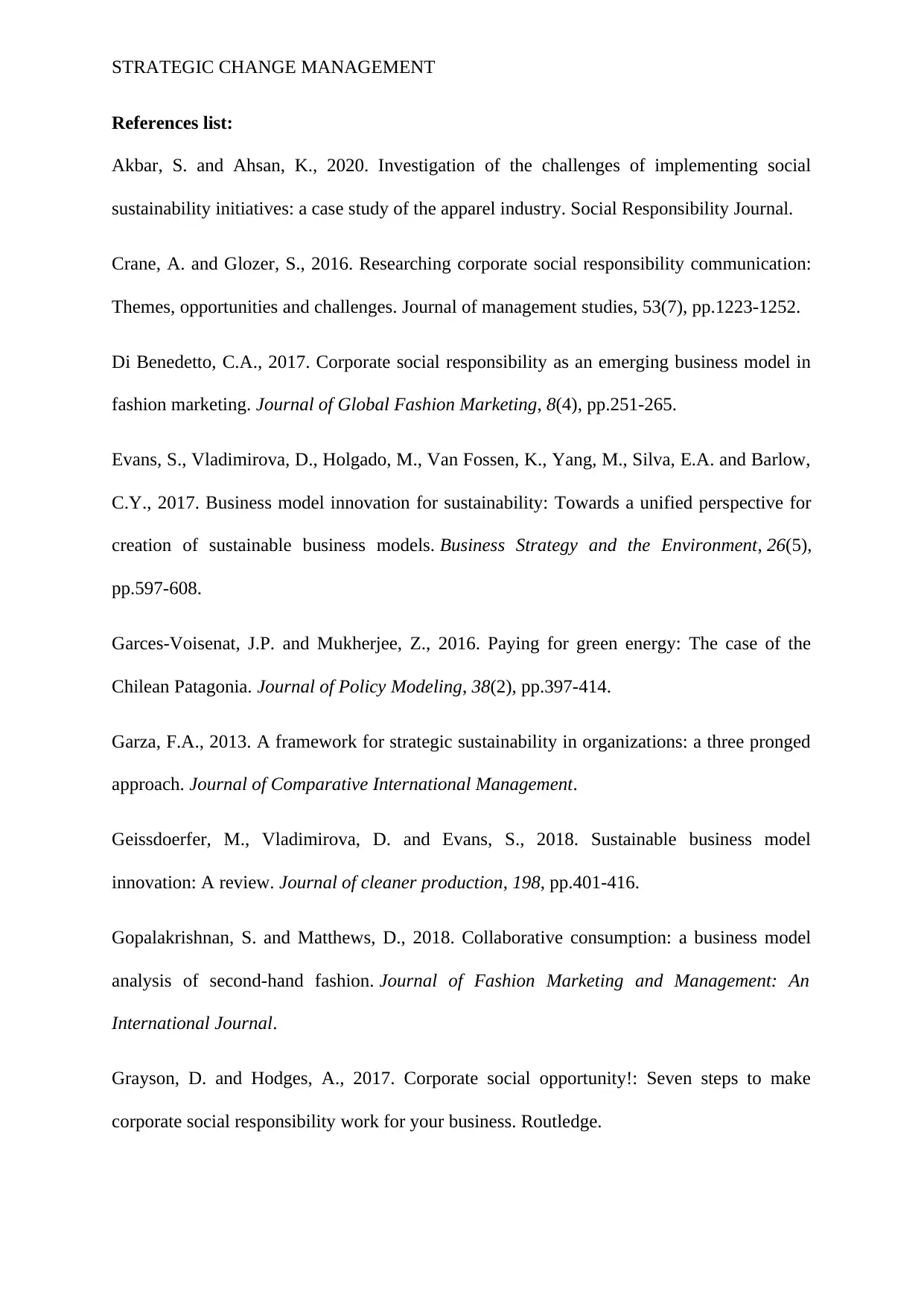
STRATEGIC CHANGE MANAGEMENT
References list:
Akbar, S. and Ahsan, K., 2020. Investigation of the challenges of implementing social
sustainability initiatives: a case study of the apparel industry. Social Responsibility Journal.
Crane, A. and Glozer, S., 2016. Researching corporate social responsibility communication:
Themes, opportunities and challenges. Journal of management studies, 53(7), pp.1223-1252.
Di Benedetto, C.A., 2017. Corporate social responsibility as an emerging business model in
fashion marketing. Journal of Global Fashion Marketing, 8(4), pp.251-265.
Evans, S., Vladimirova, D., Holgado, M., Van Fossen, K., Yang, M., Silva, E.A. and Barlow,
C.Y., 2017. Business model innovation for sustainability: Towards a unified perspective for
creation of sustainable business models. Business Strategy and the Environment, 26(5),
pp.597-608.
Garces-Voisenat, J.P. and Mukherjee, Z., 2016. Paying for green energy: The case of the
Chilean Patagonia. Journal of Policy Modeling, 38(2), pp.397-414.
Garza, F.A., 2013. A framework for strategic sustainability in organizations: a three pronged
approach. Journal of Comparative International Management.
Geissdoerfer, M., Vladimirova, D. and Evans, S., 2018. Sustainable business model
innovation: A review. Journal of cleaner production, 198, pp.401-416.
Gopalakrishnan, S. and Matthews, D., 2018. Collaborative consumption: a business model
analysis of second-hand fashion. Journal of Fashion Marketing and Management: An
International Journal.
Grayson, D. and Hodges, A., 2017. Corporate social opportunity!: Seven steps to make
corporate social responsibility work for your business. Routledge.
References list:
Akbar, S. and Ahsan, K., 2020. Investigation of the challenges of implementing social
sustainability initiatives: a case study of the apparel industry. Social Responsibility Journal.
Crane, A. and Glozer, S., 2016. Researching corporate social responsibility communication:
Themes, opportunities and challenges. Journal of management studies, 53(7), pp.1223-1252.
Di Benedetto, C.A., 2017. Corporate social responsibility as an emerging business model in
fashion marketing. Journal of Global Fashion Marketing, 8(4), pp.251-265.
Evans, S., Vladimirova, D., Holgado, M., Van Fossen, K., Yang, M., Silva, E.A. and Barlow,
C.Y., 2017. Business model innovation for sustainability: Towards a unified perspective for
creation of sustainable business models. Business Strategy and the Environment, 26(5),
pp.597-608.
Garces-Voisenat, J.P. and Mukherjee, Z., 2016. Paying for green energy: The case of the
Chilean Patagonia. Journal of Policy Modeling, 38(2), pp.397-414.
Garza, F.A., 2013. A framework for strategic sustainability in organizations: a three pronged
approach. Journal of Comparative International Management.
Geissdoerfer, M., Vladimirova, D. and Evans, S., 2018. Sustainable business model
innovation: A review. Journal of cleaner production, 198, pp.401-416.
Gopalakrishnan, S. and Matthews, D., 2018. Collaborative consumption: a business model
analysis of second-hand fashion. Journal of Fashion Marketing and Management: An
International Journal.
Grayson, D. and Hodges, A., 2017. Corporate social opportunity!: Seven steps to make
corporate social responsibility work for your business. Routledge.
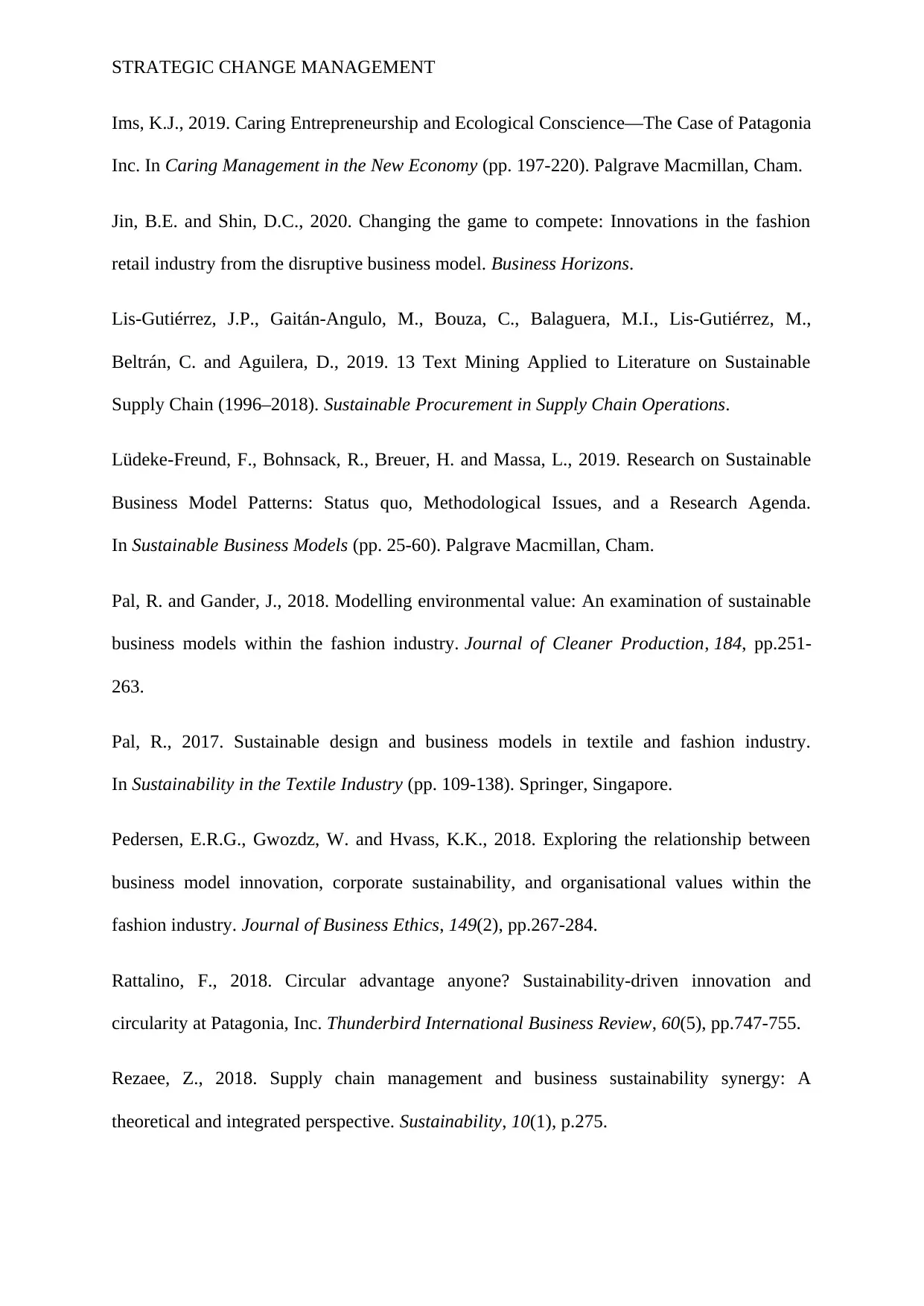
STRATEGIC CHANGE MANAGEMENT
Ims, K.J., 2019. Caring Entrepreneurship and Ecological Conscience—The Case of Patagonia
Inc. In Caring Management in the New Economy (pp. 197-220). Palgrave Macmillan, Cham.
Jin, B.E. and Shin, D.C., 2020. Changing the game to compete: Innovations in the fashion
retail industry from the disruptive business model. Business Horizons.
Lis-Gutiérrez, J.P., Gaitán-Angulo, M., Bouza, C., Balaguera, M.I., Lis-Gutiérrez, M.,
Beltrán, C. and Aguilera, D., 2019. 13 Text Mining Applied to Literature on Sustainable
Supply Chain (1996–2018). Sustainable Procurement in Supply Chain Operations.
Lüdeke-Freund, F., Bohnsack, R., Breuer, H. and Massa, L., 2019. Research on Sustainable
Business Model Patterns: Status quo, Methodological Issues, and a Research Agenda.
In Sustainable Business Models (pp. 25-60). Palgrave Macmillan, Cham.
Pal, R. and Gander, J., 2018. Modelling environmental value: An examination of sustainable
business models within the fashion industry. Journal of Cleaner Production, 184, pp.251-
263.
Pal, R., 2017. Sustainable design and business models in textile and fashion industry.
In Sustainability in the Textile Industry (pp. 109-138). Springer, Singapore.
Pedersen, E.R.G., Gwozdz, W. and Hvass, K.K., 2018. Exploring the relationship between
business model innovation, corporate sustainability, and organisational values within the
fashion industry. Journal of Business Ethics, 149(2), pp.267-284.
Rattalino, F., 2018. Circular advantage anyone? Sustainability‐driven innovation and
circularity at Patagonia, Inc. Thunderbird International Business Review, 60(5), pp.747-755.
Rezaee, Z., 2018. Supply chain management and business sustainability synergy: A
theoretical and integrated perspective. Sustainability, 10(1), p.275.
Ims, K.J., 2019. Caring Entrepreneurship and Ecological Conscience—The Case of Patagonia
Inc. In Caring Management in the New Economy (pp. 197-220). Palgrave Macmillan, Cham.
Jin, B.E. and Shin, D.C., 2020. Changing the game to compete: Innovations in the fashion
retail industry from the disruptive business model. Business Horizons.
Lis-Gutiérrez, J.P., Gaitán-Angulo, M., Bouza, C., Balaguera, M.I., Lis-Gutiérrez, M.,
Beltrán, C. and Aguilera, D., 2019. 13 Text Mining Applied to Literature on Sustainable
Supply Chain (1996–2018). Sustainable Procurement in Supply Chain Operations.
Lüdeke-Freund, F., Bohnsack, R., Breuer, H. and Massa, L., 2019. Research on Sustainable
Business Model Patterns: Status quo, Methodological Issues, and a Research Agenda.
In Sustainable Business Models (pp. 25-60). Palgrave Macmillan, Cham.
Pal, R. and Gander, J., 2018. Modelling environmental value: An examination of sustainable
business models within the fashion industry. Journal of Cleaner Production, 184, pp.251-
263.
Pal, R., 2017. Sustainable design and business models in textile and fashion industry.
In Sustainability in the Textile Industry (pp. 109-138). Springer, Singapore.
Pedersen, E.R.G., Gwozdz, W. and Hvass, K.K., 2018. Exploring the relationship between
business model innovation, corporate sustainability, and organisational values within the
fashion industry. Journal of Business Ethics, 149(2), pp.267-284.
Rattalino, F., 2018. Circular advantage anyone? Sustainability‐driven innovation and
circularity at Patagonia, Inc. Thunderbird International Business Review, 60(5), pp.747-755.
Rezaee, Z., 2018. Supply chain management and business sustainability synergy: A
theoretical and integrated perspective. Sustainability, 10(1), p.275.
⊘ This is a preview!⊘
Do you want full access?
Subscribe today to unlock all pages.

Trusted by 1+ million students worldwide
1 out of 13
Related Documents
Your All-in-One AI-Powered Toolkit for Academic Success.
+13062052269
info@desklib.com
Available 24*7 on WhatsApp / Email
![[object Object]](/_next/static/media/star-bottom.7253800d.svg)
Unlock your academic potential
Copyright © 2020–2025 A2Z Services. All Rights Reserved. Developed and managed by ZUCOL.



